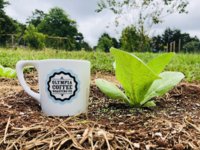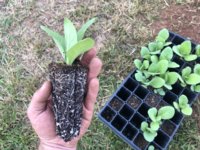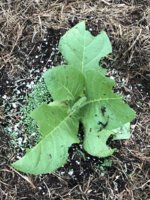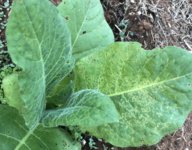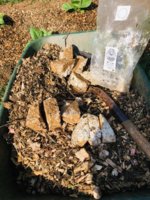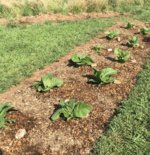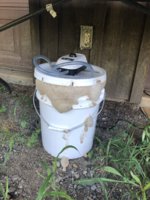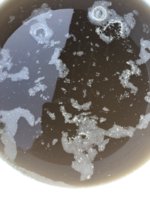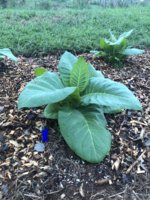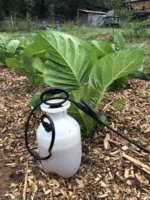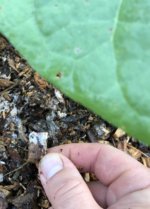dubhelix
Well-Known Member
I’m super late this year. Like six weeks late. I didn’t get to sowing seed until the day of last frost in my area (May 15th), so I may run out of curing time in autumn. But if it works out, it’ll be a good and logical progression.
I’m growing Red Front again. It’s an Austrian dark air cured variety. This is my fourth or fifth generation of homegrown seed. I forget.
Anyway, I started seed in vermiculite with a bit of peat moss. I sprinkle the seed along the edge of the starting tray, which helps the seedlings slide out easier. Each seedling is gently plucked out with tweezers and transplanted into an appropriately deep hole poked in the growing mix. I used a bale of fancy organic growing mix with mycelia and stuff from the Hydroponics store. It’s good stuff, man

The transplanted seedlings grow in 50 cell seed-starting trays designed for forestry. They’re deep. Spring for the heavy duty trays. Totally worth it. They’re bottom-watered with straight well water until they have four or five leaves, then they get a light dose of fish emulsion and a haircut at about four weeks from sowing date.
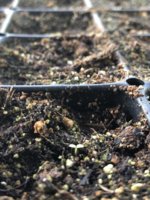
At six weeks I put them in the beds. The soil in the lower orchard is pretty nice. Looks like there was a burn pile there some years ago. I abandoned my upper-pasture tobacco patch location. Too dry, too far from my normal orbits. I’m in the orchard several times a day, and the soil is better, and there’s ducks on patrol.
This bed is about 5’ x 25’. Or so. It’ll take a dozen transplants.
I tilled the top four or five inches, and added some stuff, and tilled it again. I used a few bags of mushroom compost, and a blend of alfalfa meal, rock phosphate, lime and dolomitic lime, gypsum, and Azomite, then raked it smooth to soothe my OCD and aesthetic preferences.
Here’s the fertilizer ratios:
16 scoops seed meal
1 scoop gypsum
1 scoop Ag lime
2 scoops dolomite line
4 scoops rock phosphate
1/2 scoop Azomite powder
Each planting hole gets two shovelfuls of the humbolt-worthy grow mix, forked in and fluffed. The holes are about 3’ apart in a staggered row. Before I transplant, I mow around the bed with the discharge spout pointed toward the bed. After a few spiraling passes with the mower, the bed has a nice coating of fresh grass clippings.
After that the whole patch gets sprinkled with too much ladino clover seed and watered well.
Each transplant gets a thorough Foliar misting of mixed seaweed juice and fulvic acid (1oz/g and 1 tbsp/g) or dilute fish emulsion (1oz/gallon) every other day or so for the first week, to include soaking the fledgling root zone. The whole bed gets lightly watered every evening to sprout the clover.
The transplants were set out this year on the solstice, six weeks from seed.
This year I’m using actively aerated compost tea, made from aerobic bacterial and fungal cultures incubated in a 5-gallon pail with vigorous air flow via air stones and a pump. The brew blend is as follows:
In fine mesh bag:
2 cups earthworm castings
1 cup alfalfa seed meal
1 tablespoon Azomite
In bucket:
4.5 gallons well water
1 oz molasses
1 oz fish emulsion
1 oz seaweed emulsion
1 oz fulvic acid
Brew time on highest air flow setting: 24-36 hours.
I use this stuff as a Foliar spray on my orchard, but I’m just using it as a root soak on the tobacco.
So far so good. The little plants are 52 days from seed and seem robust.

I’m growing Red Front again. It’s an Austrian dark air cured variety. This is my fourth or fifth generation of homegrown seed. I forget.
Anyway, I started seed in vermiculite with a bit of peat moss. I sprinkle the seed along the edge of the starting tray, which helps the seedlings slide out easier. Each seedling is gently plucked out with tweezers and transplanted into an appropriately deep hole poked in the growing mix. I used a bale of fancy organic growing mix with mycelia and stuff from the Hydroponics store. It’s good stuff, man

The transplanted seedlings grow in 50 cell seed-starting trays designed for forestry. They’re deep. Spring for the heavy duty trays. Totally worth it. They’re bottom-watered with straight well water until they have four or five leaves, then they get a light dose of fish emulsion and a haircut at about four weeks from sowing date.

At six weeks I put them in the beds. The soil in the lower orchard is pretty nice. Looks like there was a burn pile there some years ago. I abandoned my upper-pasture tobacco patch location. Too dry, too far from my normal orbits. I’m in the orchard several times a day, and the soil is better, and there’s ducks on patrol.
This bed is about 5’ x 25’. Or so. It’ll take a dozen transplants.
I tilled the top four or five inches, and added some stuff, and tilled it again. I used a few bags of mushroom compost, and a blend of alfalfa meal, rock phosphate, lime and dolomitic lime, gypsum, and Azomite, then raked it smooth to soothe my OCD and aesthetic preferences.
Here’s the fertilizer ratios:
16 scoops seed meal
1 scoop gypsum
1 scoop Ag lime
2 scoops dolomite line
4 scoops rock phosphate
1/2 scoop Azomite powder
Each planting hole gets two shovelfuls of the humbolt-worthy grow mix, forked in and fluffed. The holes are about 3’ apart in a staggered row. Before I transplant, I mow around the bed with the discharge spout pointed toward the bed. After a few spiraling passes with the mower, the bed has a nice coating of fresh grass clippings.
After that the whole patch gets sprinkled with too much ladino clover seed and watered well.
Each transplant gets a thorough Foliar misting of mixed seaweed juice and fulvic acid (1oz/g and 1 tbsp/g) or dilute fish emulsion (1oz/gallon) every other day or so for the first week, to include soaking the fledgling root zone. The whole bed gets lightly watered every evening to sprout the clover.
The transplants were set out this year on the solstice, six weeks from seed.
This year I’m using actively aerated compost tea, made from aerobic bacterial and fungal cultures incubated in a 5-gallon pail with vigorous air flow via air stones and a pump. The brew blend is as follows:
In fine mesh bag:
2 cups earthworm castings
1 cup alfalfa seed meal
1 tablespoon Azomite
In bucket:
4.5 gallons well water
1 oz molasses
1 oz fish emulsion
1 oz seaweed emulsion
1 oz fulvic acid
Brew time on highest air flow setting: 24-36 hours.
I use this stuff as a Foliar spray on my orchard, but I’m just using it as a root soak on the tobacco.
So far so good. The little plants are 52 days from seed and seem robust.



